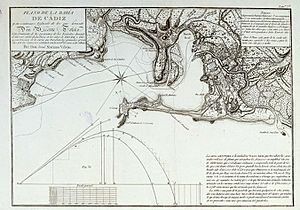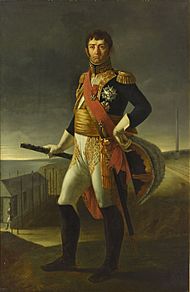Siege of Cádiz facts for kids
Quick facts for kids Siege of Cádiz |
|||||||
|---|---|---|---|---|---|---|---|
| Part of the Peninsular War | |||||||
 Map of Cádiz in 1813 |
|||||||
|
|||||||
| Belligerents | |||||||
| Commanders and leaders | |||||||
| Strength | |||||||
|
|
||||||
| Casualties and losses | |||||||
| 896 dead 3,706 wounded |
4,500–5,500 dead or wounded 30 ships destroyed |
||||||
The Siege of Cádiz was a long military attack on the Spanish city of Cádiz by the French army. It happened during the Peninsular War, which was part of the larger Napoleonic Wars. The siege lasted for over two and a half years, from February 1810 to August 1812.
Cádiz was a very important Spanish naval base. After the French took over Seville, Cádiz became the new capital for the Spanish government. About 70,000 French soldiers, led by Marshals Claude Victor and Nicolas Jean-de-Dieu Soult, tried to capture the city.
At first, only 2,000 Spanish soldiers defended Cádiz. But as the siege went on, they got help from 10,000 more Spanish troops, plus soldiers from Britain and Portugal. This group of allies (Spain, Britain, Portugal) is called the Coalition.
During the siege, a special Spanish government called the Cortes of Cádiz met in the city. They created a new constitution to limit the power of the king. This was a big deal for Spain's future.
The Coalition tried to break the siege several times. In 1810, a joint British and Spanish force tried a landing at Fuengirola, but it didn't go well. In 1811, another attempt was made near Tarifa. Even though the Coalition won a battle against a French force at Battle of Barrosa, the siege of Cádiz continued.
Finally, in 1812, a major battle called the Battle of Salamanca forced the French to leave the area. They were afraid of being trapped by the Coalition armies. The French defeat helped free Spain from their control. Cádiz remained a safe place for the Spanish government and a starting point for the Coalition forces.
Contents
Why the Siege Happened
The Siege of Cádiz was a key part of the Peninsular War. This war began when French Emperor Napoleon tried to control Europe. He wanted to stop Britain from trading with other countries. Napoleon's plan was to close all European ports to British ships. He believed that if he controlled Cádiz, he could better control trade and deal with his enemies.
In 1809, French armies invaded Portugal but were defeated by British forces led by Arthur Wellesley. The Spanish army also faced defeats. This led Wellesley to pull back into Portugal. By 1810, the war was stuck in a difficult position. Wellesley built strong defenses in Portugal, and the remaining Spanish forces gathered in Cádiz to protect their government from the French.
The Siege Begins


The French armies, led by Marshals Soult and Victor, surrounded Cádiz on land. They set up three main positions around the city. The French first asked the city to surrender, but the defenders refused.
The French attacked a fort called Matagorda, located north of Cádiz. They bombarded it with cannons until the defenders had to leave. This gave the French access to the coast near Cádiz. They used very large cannons, some called Grand Mortars, to fire huge cannonballs up to 3 miles (5 km) away. These cannons were so big that the French had to leave them behind when they retreated later. Even with these powerful weapons, the great distance made their attacks less effective.

The land around Cádiz was hard for the French to attack. Also, the French struggled to get enough supplies and ammunition. Small groups of Spanish fighters, called guerrillas, constantly attacked the French supply lines and communications. This made it very difficult for the French army to keep up the siege. One historian even said that the French siege of Cádiz was "mostly pretend" because they had little hope of actually taking the city. Instead, the French army in the area was almost under siege themselves by the Spanish guerrillas.
French reinforcements arrived in April 1810. They captured an outer Spanish fort, which helped them bring in more troops. This fort also allowed the French to fire on ships entering and leaving Cádiz.
Attempts to Break the Siege
In 1811, the French force around Cádiz became smaller. Marshal Soult needed more soldiers for another siege, so he took some away from Victor's army. This made the French numbers drop to between 15,000 and 20,000 soldiers.
Seeing this, the defenders of Cádiz decided to try to break out. About 4,000 Spanish troops, led by General José de Zayas, planned to attack. At the same time, a relief army of about 16,000 British and Spanish soldiers landed 50 miles (80 km) south of Cádiz. This force was led by Spanish General Manuel la Peña and British Lieutenant-General Sir Thomas Graham.
On February 28, 1811, this relief force marched towards Cádiz and met a French force at the Battle of Barrosa. The Coalition won this battle, even capturing a French battle flag. However, the victory did not end the siege of Cádiz.
Smaller attacks from Cádiz continued throughout 1811. In October, British ships destroyed French positions near St. Mary's, killing a French artillery commander. The French tried to attack a small British-Spanish group at Tarifa in late 1811, but heavy rains and strong defense stopped them. This marked the end of major French attacks on the outer defenses of Cádiz.
On July 22, 1812, the Coalition won a big victory at the Battle of Salamanca. After this, the Spanish, British, and Portuguese armies entered Madrid. The French commander, Soult, realized his army was in danger of being cut off. He ordered a retreat from Cádiz on August 24, 1812. Before leaving, the French destroyed most of their 600 cannons so the Coalition couldn't use them. The Coalition forces captured many cannons, 30 gunboats, and a lot of supplies.
What Happened Next

The French retreat from Cádiz was a big moment in the Peninsular War. It showed that the French army could be defeated. The survival of the Spanish government in Cádiz and its use as a base for the Coalition forces were very important. This helped lead to the eventual liberation of Spain from French control.
In Books
- The Siege of Cádiz is a major part of Bernard Cornwell's book Sharpe's Fury. In the story, the character Richard Sharpe helps defend the city.
- Arturo Pérez-Reverte's book El asedio (which means The Siege in English) is a mystery story that takes place in Cádiz during the siege.
See also
 In Spanish: Sitio de Cádiz para niños
In Spanish: Sitio de Cádiz para niños


